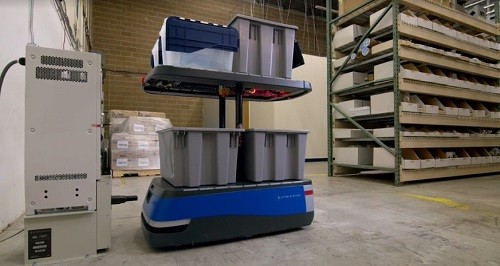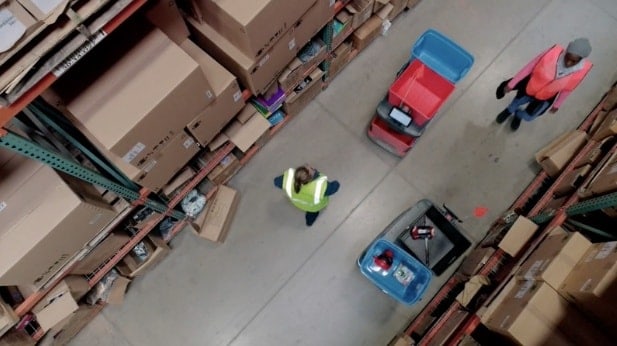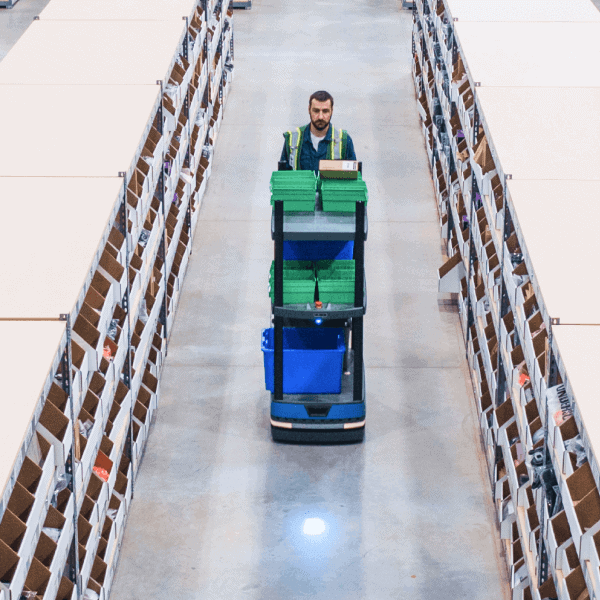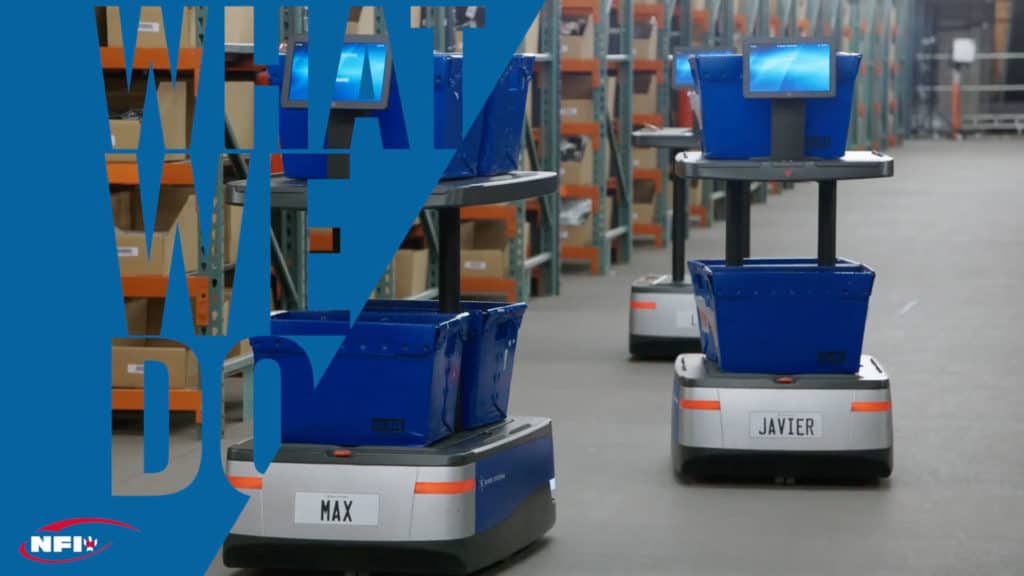Sometimes called self-guided vehicles or autonomous guided vehicles, automated guided vehicles (AGVs) are material handling systems or load carriers that travel autonomously throughout a warehouse, distribution center, or manufacturing facility, without an onboard operator or driver. In this post, we’ll explore the various types of AGVs, the meaning of them, how they work and their benefits.
Applications for AGVs
Automated guided vehicle systems are used for tasks that would typically be handled by forklifts, conveyor systems or manual carts, moving large volumes of material in a repetitive manner.
AGVs are used in a variety of applications. They’re often used for transporting raw materials such as metal, plastic, rubber or paper. For example, AGVs can transport raw materials from receiving to the warehouse or deliver materials directly to production lines. AGVs consistently and reliably deliver raw materials needed without human intervention, ensuring that production lines always have the materials they need without interruption.
In addition to transporting raw materials, AGVs are used in work-in-process applications and with finished goods to support production or manufacturing lines. According to Investopedia, the term work-in-process describes “partially completed goods, which are typically turned from raw material to finished product in a short period of time,” such as manufactured goods. In work-in-process applications, AGVs move materials or parts from the warehouse to production lines or from one workstation to another, providing repetitive and efficient movement of materials throughout the manufacturing process. Without AGVs, manufacturing processes may come to a halt when processing lines run out of materials. Manufacturing is then delayed while a human worker retrieves the necessary materials from storage and transports them to the production line.
AGVs are also used in inbound and outbound handling for replenishment and for picking. For example, AGVs may be used to transport inventory from receiving to storage locations or from long-term storage locations to forward picking locations to replenish stock. Moving inventory from long-term storage to forward picking locations ensures that adequate inventory is accessible to pickers, making the order picking process more efficient. AGVs such as collaborative mobile robots assist in the picking process by guiding warehouse associates through tasks and transporting picked orders to packaging and shipping workstations.
Types of Automated Guided Vehicles

There are several types of automated guided vehicles. Many AGVs are similar to other human-operated vehicles but are designed to operate without direct human intervention or guidance.
Automated Guided Carts
An automatic guided cart (AGC) is the most basic type of AGV with minimal features. Navigation systems can range from systems as simple as magnetic tape to complex, sensor-based navigation systems that use AI to navigate their environment. They can transport a variety of materials, from small parts to loaded pallets, and are often used in sorting, storage, and cross-docking applications.
One example of an AGC is an automated hospital cart transporter, used to efficiently transport compact loads throughout a hospital, such as meals and empty food trays, clean or soiled linens, biohazard waste or sterile supplies. Without the need for a staff member to manually push the cart from place to place, automated hospital cart transporters can help to reduce labor costs.
Forklift AGVs
Fork vehicles, or forklift automatic guided vehicles, are another commonly used type of AGV. They’re designed to perform the same functions a human-operated forklift performs (transporting pallets), but without the need for a human operator.
Towing AGVs
Towing vehicles, or tugger automatic guided vehicles, pull one or more non-powered, load-carrying vehicles behind them in a train-like formation. Sometimes called driverless trains, powered towing vehicles travel on wheels. Tugger automatic guided vehicles are often used for transporting heavy loads over longer distances. They may have several drop-off and pick-up stops along a defined path through a warehouse or factory.
Unit Load Handlers
Unit load handlers carry discrete loads such as individual objects, or a single unit such as a pallet or tote that contains multiple items.
Heavy Burden Carriers
For the heaviest loads, heavy burden carriers are a type of AGV used in applications such as large assembly, casting and coil and plate transport. Some heavy burden carriers have self-loading capabilities and may have standard, pivot or omni-directional steering.
Autonomous Mobile Robots
Autonomous mobile robots (AMRs) are typically more technologically advanced than other types of AGVs. While many AGVs use fixed navigation systems, such as wires or magnetic tape, many AMRs are equipped with intelligent navigation capabilities such as sensors and camera systems that enable them to detect and navigate around obstacles. Thanks to more sophisticated technology, AMRs can dynamically navigate a warehouse or other facility and plan the most efficient paths.
How AGVs work

AGVs are self-propelled vehicles with movement guided by software and sensors. Most AGVs move along defined pathways, but as mentioned, AMRs typically have more advanced technology with dynamic navigation capabilities.
AGV navigation
AGV navigation may be guided using one or more of the following mechanisms:
- Magnetic guide tape — some AGVs have magnetic sensors and follow a track using magnetic tape.
- Wired navigation — some AGVs follow wire paths embedded into the facility floor. The wire transmits a signal that AGVs detect via an antenna or sensor.
- Laser target navigation — with this method, reflective tape is mounted on objects such as walls, fixed machines and poles. AGVs are equipped with a laser transmitter and receiver. The lasers reflect off of the tape within the line of sight and used to calculate the object’s angle and distance from the AGV.
- Inertial (gyroscopic) navigation — some AGVs are controlled by a computer system with the aid of transponders embedded into the facility floor to verify that the AGV is on the proper course.
- Vision guidance — No modification is required to the infrastructure for vision-guided AGVs. Cameras record the features along the route, and AGVs rely on these recorded features to navigate.
- Geoguidance — Like vision-guided AGVs, no infrastructure modifications are required for AGVs that use geoguidance. Geoguided AGVs recognize objects in their environment to establish their location in real-time to navigate throughout the facility.
- LiDAR — LiDAR (Light Detection and Ranging) is a sophisticated navigation technology utilizing sensors that transmit laser pulses to measure the distance between the robot and objects in its environment. This data is compiled to create a 360-degree map of the environment, allowing robots to navigate the facility and avoid obstacles without the need for any additional infrastructure. 6 River Systems uses LiDAR navigation technology to enable their AGVs to navigate a warehouse without requiring changes to infrastructure as well as to adapt to new environments should the layout of a warehouse floor change.
AGV steering
AGV steering is controlled by differential speed control, steered wheel control or a combination of the two:
- Differential speed control — This is the most common type of steering control used by AGVs. Differential speed control uses two independent drive wheels. Each drive wheel is driven at a different speed to turn. To go forward or backwards, the two drives are driven at the same speed. The simplest steering control option for AGVs, differential speed control doesn’t require additional steering motors or mechanisms. It is commonly used for AGVs that operate in tight spaces or for those that operate near machines. It is not used for towing applications, as it can cause a trailer to jackknife while turning.
- Steered wheel control — This type of steering control is similar to the steering control in a car or truck. In steered wheel control, the drive wheel is the turning wheel. Steered wheel control is more precise than differential speed control and offers smoother turning. It is often used for towing applications and may also be operator-controlled.
- Combination steering — This is a combination of differential speed control and steered wheel control. AGVs using combination steering have two independent steer/drive motors on diagonal corners of the AGV and swiveling castors on the other two corners. AGVs using combination steering can turn in any direction like a car and also drive in differential steering mode in any direction.
AGV traffic control
Traffic control measures include zone control, collision avoidance or a mix of both:
- Zone control — Simple to install and easy to expand, zone control is a commonly used traffic control method for AGVs. A wireless transmitter transmits signals in defined areas, and the AGV contains a sensor that receives the signal and transmits it back to the transmitter. If the area is clear, a “clear” signal is sent that allows the AGV to enter or pass through the area. If another AGV is in the area, a “stop” signal is sent that alerts other AGVs attempting to enter that the area is not clear. In this case, the waiting AGVs will stop and wait until the first AGV moves out of the zone and a “clear” signal is sent by the transmitter. Another way zone control can be used is by equipping each AGV with its own transmitter, allowing it to send a “do not enter” signal to other AGVs approaching the zone.
- Collision avoidance — AGVs using collision avoidance zone control are equipped with sensors that transmit a signal and wait for a reply to determine if an object is in front of it. These sensors may be sonic, which work like radar, or optical, which uses infrared sensors. Both work in a similar manner. Bumper sensors are another type of collision avoidance sensor. Many AGVs are equipped with bumper sensors as a fail-safe. Bumper sensors stop to avoid a collision when they sense physical contact.
- Combination control — AGVs that use combination control are equipped with both collison control sensors and zone control sensors in order to offer more robust collision prevention in all situations. For instance, an AGV may use zone control as its primary traffic control system but also have collision avoidance sensors as a backup in case the zone control system malfunctions.
Benefits of AGVs
AGVs offer numerous benefits in warehousing and manufacturing.
Increase efficiency and productivity
Because they operate autonomously, AGVs increase efficiency and productivity, and they’re predictable and reliable for repetitive tasks. AGVs eliminate unnecessary walking and also eliminate the physical labor of transporting materials. They set the pace for workers, as well, keeping associates on-task. AGVs like collaborative mobile robots guide associates through each task, reducing human error, which helps to improve order picking accuracy and minimize loss and misplaced products. By leveraging AI to optimize routes and prioritize work, collaborative mobile robots improve resource utilization.
Consistent costs
AGVs are typically acquired on a per unit or per rental period cost basis, so there’s less fluctuation in costs compared to human labor, which can fluctuate based on market conditions and demand.
Flexibility
Some AGVs offer the flexibility of easily changing routes (compared to others which require re-routing guide wires or other infrastructure to adjust a vehicle’s route). Automated guided vehicles are a scalable solution, as well, with the ability to add additional units based on demand.
Less space required
Compared to other automation solutions, such as conveyor systems, AGVs require less space. Some AGVs are smaller compared to traditional warehouse equipment, such as forklifts, which allows for floor layouts with narrower aisles and better space utilization.
Improved safety
Finally, AGVs are a safe automation solution for warehouses, distribution centers and manufacturing facilities. AGVs are equipped with sensors to avoid collisions. Advanced AGVs like AMRs have intelligent routing capabilities that enable them to plan the most efficient path through a warehouse or facility, reducing aisle congestion and preventing injuries.
Automated guided vehicles are uniquely designed to automate tasks for which humans are not necessary. They automate long walks in warehouses, set the pace for workers, and eliminate the physical rigors of a traditionally physically demanding job. Chuck by 6 River Systems is a flexible, scalable and cost-effective solution for warehouses and distribution centers offering innovative technology designed to tackle some of warehousing’s biggest challenges.
Is your operation ready for AGVs? Consult this IDC study to assess your warehouse or fulfillment center’s maturity level. We can also discuss the solution that’s right for you. Contact us today.


